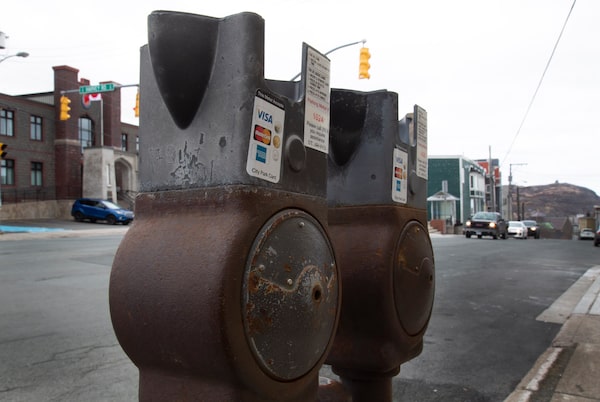
Parking meters with the heads cut off on Harvey Road in St. John’s.Paul Daly/The Globe and Mail
Cheap downtown parking has hit a new low in historic St. John’s, where meters are everywhere but it is often impossible to pay even with the correct change.
Nearly all of the coin-operated meters in the city have been decapitated by vandals since 2015, including so many replacements that the city has given up on fixing them.
“People are smashing the heads off them because they’re easy to break – they’re lopping the heads off for the bit of coin that’s in them,” said Debbie Hanlon, a city councillor who leads the transportation file. “It’s just blatant vandalism. And it’s costing us a fortune.”
While it costs around $400 to fix each broken meter, the city estimates it has lost nearly $3-million from missed parking and enforcement revenue alone from 2015 to 2018, according to figures provided by spokeswoman Kelly Maguire. During that span, more than 1,000 of the city’s 1,167 parking meters were severely damaged in what it terms “extreme parking meter vandalism.”
As of last month, 400 meters in the city remained headless with “no meter mechanism in operation,” Ms. Maguire said.
For drivers, though, that means many of the downtown spaces are essentially free to park in.
“Whoever is doing this is like a parking meter Robin Hood,” said Nicole Penney, a resident of the city.
Downtown businesses, however, see the culprits as far from heroic.
“It’s human nature, if you can park for free you’re going to park for free,” said Gaylynne Gulliver, marketing and special events manager for Downtown St. John’s, a business-development organization.
“But a free meter is not really free at all,” she said.
Ms. Gulliver explained that spaces with broken meters have become attractive to office and government building workers who would normally pay for garage parking or for a monthly street pass for day-long parking in the downtown core. Now, many vie for a decapitated meter space to use for the entire workday because they know ticketing has been suspended.
“Those meters are not turning over the way they should be every two or three hours,” Ms. Gulliver said. “That is very harmful for business.”
One study she submitted to the city estimated that the problem costs streetside storefronts between $300 and $500 a day in lost revenue.
Byron Murphy is the long-time proprietor of Byron’s Upstairs, a men’s clothing store on Water Street. The broken meters – and resulting lack of daytime turnover in spaces – has had “a huge impact” on his business, he said.
“People want to come down and park for an hour or so, go to the bank and maybe you come in to see me,” he said. “People are calling all the time saying they can’t get a space. It needs to be addressed.”
City figures show there have been about 90 incidents of meter vandalism since 2015. While police have laid some related charges, Constable James Cadigan, a spokesman for the Royal Newfoundland Constabulary, said the force has not kept statistics on exactly how many.
As for motive, Constable Cadigan said vandals are less likely to be vigilantes making a statement on the cost of parking and more likely to be battling addictions or difficult circumstances.
“The driver behind these crimes would generally be to obtain the money in the meters,” he said.
The meters that do work don’t tend to have much in them; Ms. Hanlon, the city councillor, said $15 is the maximum each can hold.
“It’s indicative of the mental-health situation people are finding themselves in and of drug and alcohol use in the city,” Ms. Hanlon said. “People are desperate.”
Figuring out a fix has been difficult and, at times, contentious.
Last year, Ms. Hanlon threatened to have vehicles ticketed when they park in front of broken meters for more than two hours. Her hardline position was an unpopular one.
The only real solution, Ms. Hanlon said, is moving to an entirely “cashless” system.
A request for proposals to supply and service a new city parking system with “parking meters suitable to replace the City’s existing single space meters” was issued last month.
Meanwhile, a pilot project to explore the use of app-based paid parking has been under way since last June. About 150 meters were removed along Harbour Drive on the waterfront and replaced with a pay-by-phone zone. People can use an app or dial a telephone to pay with a credit card.
Ms. Hanlon said the success of the program gives her confidence that a move to a fully cashless system is the right direction for downtown St. John’s.
But Mr. Murphy, the clothier, is not so certain.
“There’s a lot of old-time shoppers who still come down and they’re not going to be fumbling with their phone to add an app,” he said. “To try to do this without coins is going to be disastrous.”